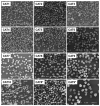Parallel Catalyst Synthesis Protocol for Accelerating Heterogeneous Olefin Polymerization Research
- PMID: 38139980
- PMCID: PMC10747057
- DOI: 10.3390/polym15244729
Parallel Catalyst Synthesis Protocol for Accelerating Heterogeneous Olefin Polymerization Research
Abstract
The data scientific approach has become an indispensable tool for capturing structure-performance relationships in complex systems, where the quantity and quality of data play a crucial role. In heterogeneous olefin polymerization research, the exhaustive and multi-step nature of Ziegler-Natta catalyst synthesis has long posed a bottleneck in synthetic throughput and data generation. In this contribution, a custom-designed 12-parallel reactor system and a catalyst synthesis protocol were developed to achieve the parallel synthesis of a magnesium ethoxide-based Ziegler-Natta catalyst. The established system, featuring a miniature reaction vessel with magnetically suspended stirring, allows for over a tenfold reduction in synthetic scale while ensuring the consistency and reliability of the synthesis. We demonstrate that the established protocol is highly efficient for the generation of a catalyst library with diverse compositions and physical features, holding promise as a foundation for the data-driven establishment of the structure-performance relationship in heterogeneous olefin polymerization catalysis.
Keywords: Ziegler-Natta catalyst; miniature; morphology; olefin polymerization; parallel synthesis.
Conflict of interest statement
The authors declare no conflict of interest. The funders had no role in the design of the study; in the collection, analyses, or interpretation of data; in the writing of the manuscript; or in the decision to publish the results.
Figures








References
-
- Kissin Y.V. Active centers in Ziegler–Natta catalysts: Formation kinetics and structure. J. Catal. 2012;292:188–200. doi: 10.1016/j.jcat.2012.05.012. - DOI
-
- Correa A., Piemontesi F., Morini G., Cavallo L. Key elements in the structure and function relationship of the MgCl2/TiCl4/Lewis base Ziegler−Natta catalytic system. Macromolecules. 2007;40:9181–9189. doi: 10.1021/ma071294c. - DOI
-
- Bahri-Laleh N., Correa A., Mehdipour-Ataei S., Arabi H., Haghighi M.N., Zohuri G., Cavallo L. Moving up and down the titanium oxidation state in Ziegler−Natta catalysis. Macromolecules. 2011;44:778–783. doi: 10.1021/ma1023582. - DOI
-
- Groppo E., Gallo E., Seenivasan K., Lomachenko K.A., Sommazzi A., Bordiga S., Glatzel P., van Silfhout R., Kachatkou A., Bras W., et al. XAS and XES techniques shed light on the dark side of Ziegler–Natta catalysts: Active-site generation. ChemCatChem. 2015;7:1432–1437. doi: 10.1002/cctc.201402989. - DOI
Grants and funding
LinkOut - more resources
Full Text Sources

